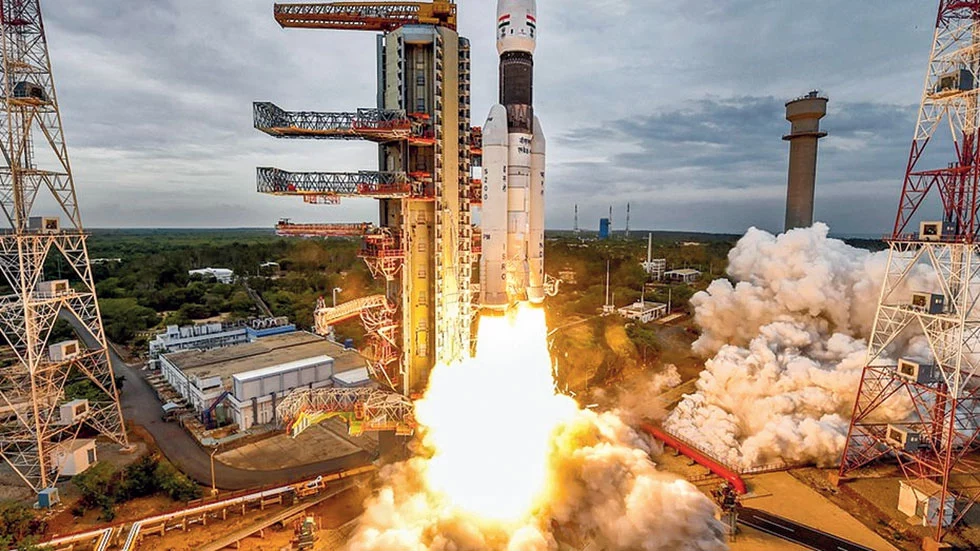On July 14, 2023 at 2:35 pm (IST), India’s Chandrayaan 3 mission is scheduled to lift off. A lander and rover will be soft-landed on the lunar surface as part of the mission. After the Chandrayaan-2 mission’s failed attempt to land on the Moon in 2019, this will be India’s second try.
The lander, the rover, and the propulsion module are the three primary parts of the Chandrayaan-3 mission. The mission’s safe lunar landing will be the responsibility of the lander. The rover will then launch from the lander and spend up to 14 days exploring the lunar surface. The lander and rover will travel to the Moon on the propulsion module before returning to Earth.

Three key goals of the Chandrayaan-3 mission
• To Expore that soft landings on the Moon are possible.
• To investigate the environment and geology of the moon.
• To develop and demonstrate fresh technology needed for upcoming extraterrestrial expeditions.For India’s space programme, the Chandrayaan-3 mission represents a critical turning point. India would become the fourth nation to successfully land on the moon if it were to succeed. Invaluable information about the geology and environment of the Moon will also be provided by the mission, which may aid in the understanding of the development of our solar system.
The Chandrayaan-3 mission is evidence of the diligence and commitment of ISRO’s scientists and engineers. The mission also serves as a representation of India’s expanding technological capability. The Chandrayaan-3 mission is expected to be a success, and ISRO is excited to share the mission’s results with the world.
To achieve the mission objectives, several advanced technologies are present in Lander such as,
- Altimeters: Laser & RF based Altimeters
- Velocimeters: Laser Doppler Velocimeter & Lander Horizontal Velocity Camera
- Inertial Measurement: Laser Gyro based Inertial referencing and Accelerometer package
- Propulsion System: 800N Throttleable Liquid Engines, 58N attitude thrusters & Throttleable Engine Control Electronics
- Navigation, Guidance & Control (NGC): Powered Descent Trajectory design and associate software elements
- Hazard Detection and Avoidance: Lander Hazard Detection & Avoidance Camera and Processing Algorithm
- Landing Leg Mechanism.
To demonstrate the above said advanced technologies in earth condition, several Lander special tests have been planned and carried out successfully viz.
- Integrated Cold Test – For the demonstration of Integrated Sensors & Navigation performance test using helicopter as test platform
- Integrated Hot test – For the demonstration of closed loop performance test with sensors, actuators and NGC using Tower crane as test platform
- Lander Leg mechanism performance test on a lunar stimulant test bed simulating different touch down conditions.

What basically differentiates Chandrayaan-3 from Chandrayaan-2?
Here is a brief summary:
Payload: Like Chandrayaan-2, Chandrayaan-3 will be equipped with a lander and rover. In contrast to Vikram on Chandrayaan-2, which had five 800 Newtons engines with a fifth one being centrally installed with a fixed thrust, the Chandrayaan-3 lander will only have four throttle-able engines. The Chandrayaan-3 lander will also be fitted with an LDV, or Laser Doppler Velocimeter. In comparison to Chandrayaan-2, the impact legs have been strengthened, and instrument redundancy has been increased. ISRO is focusing on increasing structural stiffness and incorporating numerous backup mechanisms.
Orbiter: Chandrayaan-3 won’t have an orbiter on board. The Chandrayaan-2 orbiter is still in orbit around the Moon and will keep running for a while longer.
Mission objectives: Chandrayaan-3’s mission goals are identical to those of Chandrayaan-2. The major goal is to show that a soft landing on the Moon is possible. The project will also research new technologies required for the upcoming interplanetary trips, as well as explore the geology and environment of the moon.
Chandrayaan-3’s mission is more specific than Chandrayaan-2’s overall. Instead of conducting a comprehensive range of scientific studies, the goal is to merely show that gentle landings on the Moon are possible. By doing this, ISRO will be able to learn from Chandrayaan-2’s errors and raise their chances of success in the future.

Chandrayaan 3: Will it be a hit?
It is still too early to predict with certainty if Chandrayaan-3 will be a success. However, Chandrayaan-2’s failure has taught ISRO a lot of valuable lessons. The lander and rover have undergone a number of modifications, and they are optimistic that the mission will be a success. Whether Chandrayaan-3 will be a success will only become clear on July 14, 2023. Chandrayaan-3 will be launched on July 14, 2023, at 2:35 pm (IST) from the Satish Dhawan Space Centre in Sriharikota. However, if the mission is successful, it will be a tremendous accomplishment for India’s space programme.

